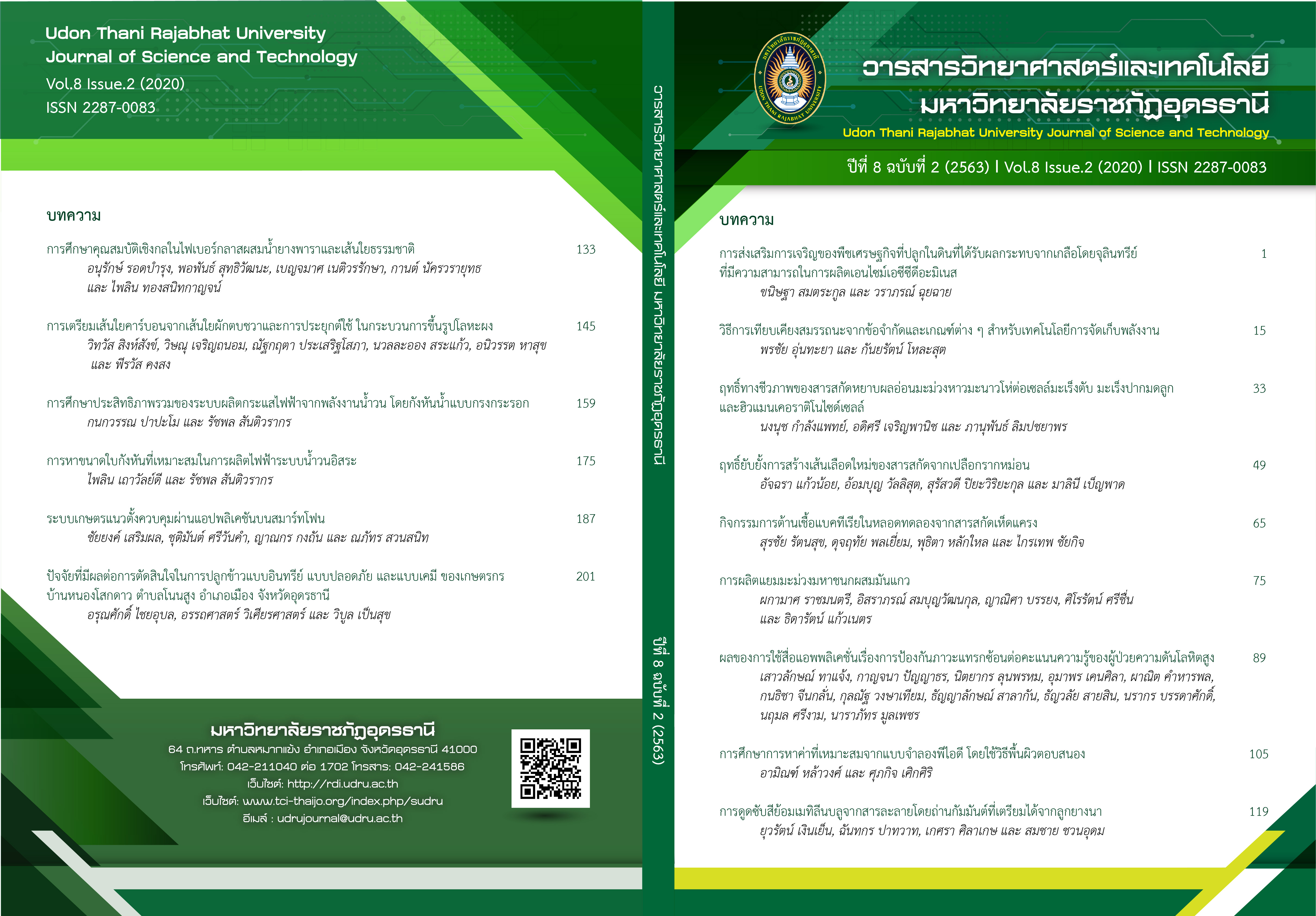PRODUCTION OF MAHACHANOK (Mangifera indica L.) MANGO YAM MIXED WITH YAM BEAN (Pachyrhizus erosus)
Main Article Content
Abstract
Mahachanok mangoes and yam beans are important agricultural products with a large amount of production in Maha Sarakham Province which can be value added through product processing for the communities and farmers in the area. This research aimed to examine the production process of Mahachanok mango mixed with yam bean jam by studying the variation in the ratio of ingredients between Mahachanok mango and yam bean that affects the sensory satisfaction of the consumers, the amount of pectin affecting the viscosity of the jam as well as the chemical and physical qualities and the microbial quality of jam products throughout the shelf life. The results reveal that the satisfaction scores of the appearance, color, smell, taste, jam spreading (viscosity), texture and overall preference of jam formulated with mango to yam bean at the 3:1 ratio had the highest overall preference score of 7.42 which was statistically significant different from the other jam formulas (p<0.05). The appropriate pectin concentration for Mahachanok mango jam mixed with yam bean was at 2% (by weight) which resulted in the jam viscosity of 26,950.00 cP. Which was no statistical different from the mango jam regulators. In addition, the study results of shelf life of Mahachanok mango mixed with yam bean jam at the room temperature for 90 days reveal that the pH and dissolved solids were 3.20-3.45 and 66.05-68.95 ºBrix, respectively which was in accordance with the standard of jam and there was a tendency for slightly color changes. In addition, the maximum total microbial content was at 2.03 × 102 CFU/g but there were no growths of bacteria, coliforms and E. coli, yeast and mold found. This shows that the product of Mahachanok mango mixed with yam bean jam production was safe according to the standard of the announcement of the Ministry of Public Health and Community Product Standards
Article Details
References
กรมส่งเสริมการเกษตร. (2554). มันแกว. กรุงเทพฯ: สำนักพัฒนาการถ่ายทอดเทคโนโลยี กรมขนส่งการเกษตร.
กระทรวงสาธารณสุข. (2543). แยม เยลลี่ และมาร์มาเลดในภาชนะบรรจุที่ปิดสนิท. นนทบุรี: กระทรวงสาธารณสุข.
จุฑามาศ นิวัฒน์, ปิยาภรณ์ เชื่อมชัยตระกลู และ ณัฐวุฒิ ดอนลาว. (2558). การพัฒนาผลิตภัณฑ์แยมผลไม้เพื่ออสุขภาพของกลุ่มวิสาหกิจชุมชนบ้านห้วยน้ำกืน อำเภอเวียงป่าเป้า จังหวัดเชียงราย. วารสารการพัฒนาชุมชนและคุณภาพชีวิต, 3(2), 151-159.
วัชรี เทพโยธิน. (2554). ซอร์ปชันไอโซเทอร์ม สมบัติทางเคมีกายภาพ และอุณหภูมิกลาสทราซิชันของน้ำมะม่วงมหาชนกผง. รายงานการวิจัย, มหาวิทยาลัยเชียงใหม่.
สารานุกรมไทยสำหรับเยาวชนโดยพระราชประสงค์ในพระบาทสมเด็จพระเจ้าอยู่หัว. (2530). มันแกว. กรุงเทพฯ: โครงการสารานุกรมไทยสำหรับเยาวชน.
สำนักงานมาตรฐานผลิตภัณฑ์อุตสาหกรรม. (2561). มาตรฐานผลิตภัณฑ์ชุมชนแยม มผช.342/2561. กรุงเทพฯ: กระทรวงอุตสาหกรรม
สภาพร อภิรัตนานุสรณ์. (2554). การพัฒนาแยมมังคุดแคลอรี่ต่ำผสมเปลือกมังคุด. วารสารวิจัย มหาวิทยาลัยขอนแก่น, 16(7), 825-834.
อุดมพงษ์ ตวงประยงค์. (2560). มันแกว. ระบบจัดเก็บและรายงานข้อมูลภาวการณ์ผลิตพืชรายเดือนระดับตำบล (รต.) ศูนย์เทคโนโลยีสารสนเทศและการสื่อสาร: กรมส่งเสริมการเกษตร.
อุดร จิตรจักร, สิทธิโชค พรรค์พิทักษ์ และ อรรควุธ แก้วสีขาว. (2558). ระบบฐานข้อมูลสารสนเทศภูมิศาสตร์ ผู้ปลูกมะม่วงมหาชนก อันเนื่องมาจากโครงการในพระราชดำริในเขตพื้นที่จังหวัดกาฬสินธุ์ และจังหวัดมหาสารคาม เพื่อต่อยอดเชิงณิชย์. รายงานการวิจัย, มหาวิทยาลัยราชภัฏมหาสารคาม.
AOAC. (2000). Official methods of analysis of the association of official analytical chemists. Washington, D.C.
Basu, S., & Shivhare, U. S. (2010). Rheological, textural, micro-structural and sensory properties of mango jam. Journal of Food Engineering, 100, 357-365.
Kirk, R. S., & Sawyer, R. (1991). Pearson’s Composition and Analysis of Foods. 9th ed. (student edition), England: Addision Wesley Longman Ltd. 33-36.
Koubala, B. B., Kansci, G., Gamier, C., Ralet, M. C., & Thibault, J. F. (2012). Mango (Mangifera indica) and Ambarella (Spondias cytherea) peel extracted pectins improve viscoelastic properties of derived jams. African Journal of Food Agriculture, Nutrition & Development, 12(3), 6200-6212.
USDA Agricultural Research Service. (2008). Mango, raw. USDA National Nutrient Database for Standard Reference, Release 21.


